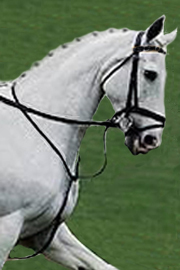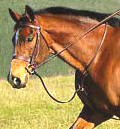
Standing Martingale
 The
Standing martingale consists of a neckstrap which goes round the base
of the horse's neck, and another strap which goes through a slit in the
neckstrap or breastplate attachment at the breast, looping around the
girth on the saddle at one end and to the back of a cavesson or flash
noseband at the other.
The
Standing martingale consists of a neckstrap which goes round the base
of the horse's neck, and another strap which goes through a slit in the
neckstrap or breastplate attachment at the breast, looping around the
girth on the saddle at one end and to the back of a cavesson or flash
noseband at the other.
The purpose of a standing martingale is to encourage a horse to keep its head lower by putting pressure on the nose - which is why it is attached to the nose band.
In theory a standing martingale is a type of safety device to prevent the rider from being hit in the face if the horse tries to throw its head too high.
It is not popular with all riders, but it is very useful to use a standing martingale on a horse confirmed in the habit of going with his head much too high, which cannot be resolved in any other way.
Some horses will only occasionally put up their heads beyond the 'correct' height, but others may go like this all the time when being ridden.
Nowadays the standing martingale is seen more on the polo field and out hunting than anywhere else.
USING A STANDING MARTINGALE ON A HORSE FOR SAFETY REASONS

Standing martingales are certainly a safety device to be recommended on a horse which, for whatever reason, has developed the habit of throwing his head up and back, maybe with a lift of the forehand, with the accompanying risk of hitting his rider in the face with his poll.
Young horses, in particular, go through all sorts of phases even with highly expert trainers, and this trick is not uncommon, even when there is no apparent cause for such behaviour.
CORRECT FITTING OF A STANDING MARTINGALE
The correct fitting of a standing martingale allows you to fit almost the width of a hand between the throat and the strap passing to the noseband when this strap is pressed up the line of the gullet.
If it is longer it will be useless; if shorter, the horse could learn to lean on it and possibly not only rely on it for balance, but also develop the wrong muscles in work. It could also dangerously restrict his action, particularly when jumping.
JUMPING A HORSE IN A STANDING MARTINGALE
Most trainers would advise that you should not jump a horse in a standing martingale. That doesn't mean people don't do it.
A horse uses its neck to balance itself. If a horse is tied to its own chest over a jump, he will tighten his back muscles and create tension and a loss of balance. The makes it very possible that the horse may fall, injuring both the horse and its rider.
If a standing martingale is fitted too loosely, then it has no effect whatsoever but creates the danger of the horse getting one of its legs caught through it as its jumps over a fence.
Many riders that do jump a horse in a standing martingale will use an elasticated martingale attachment to make it a little less severe.
ALTERNATIVES TO STANDING MARTINGALES
There are several types of horse martingales. A lot of riders prefer to use a market harborough martingale, or a running martingaleinstead of a standing martingale when jumping.